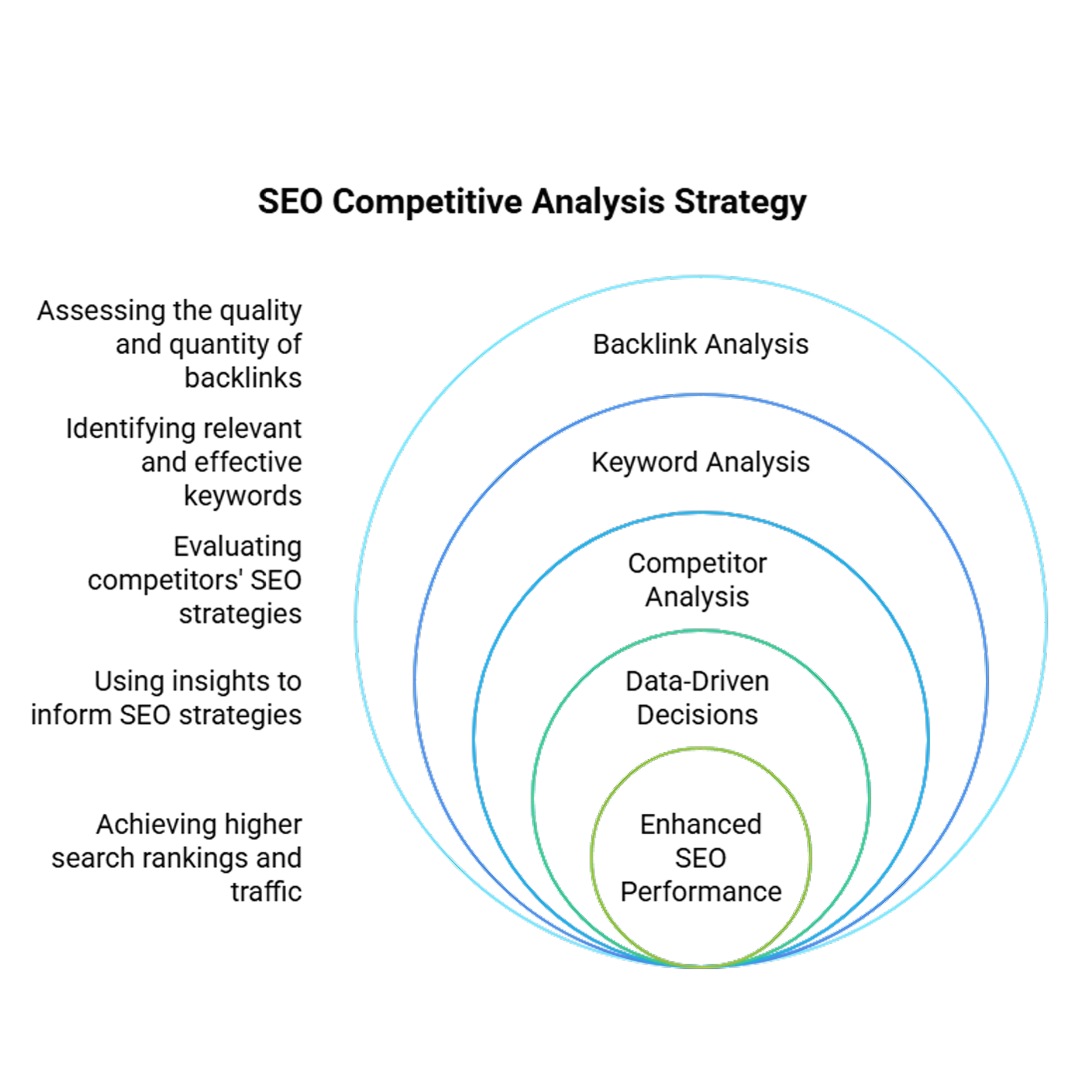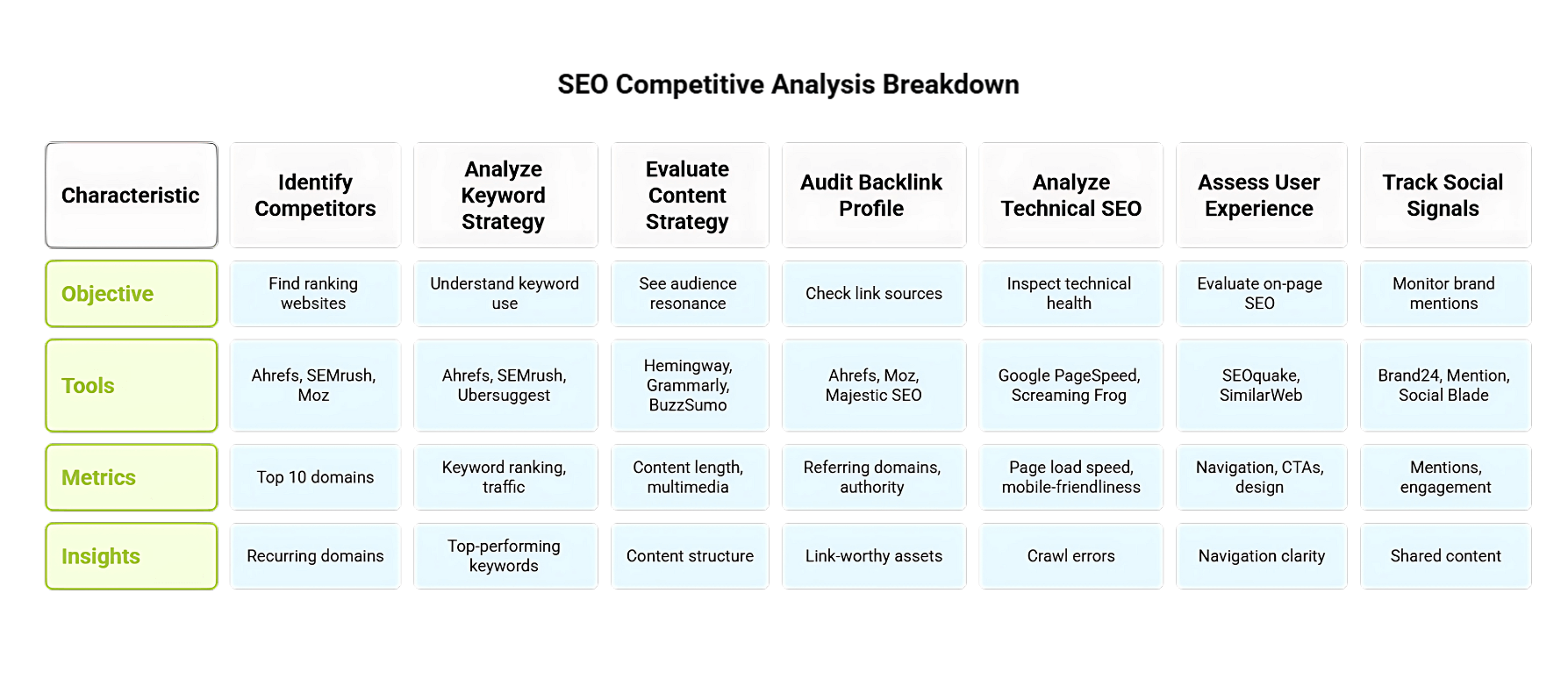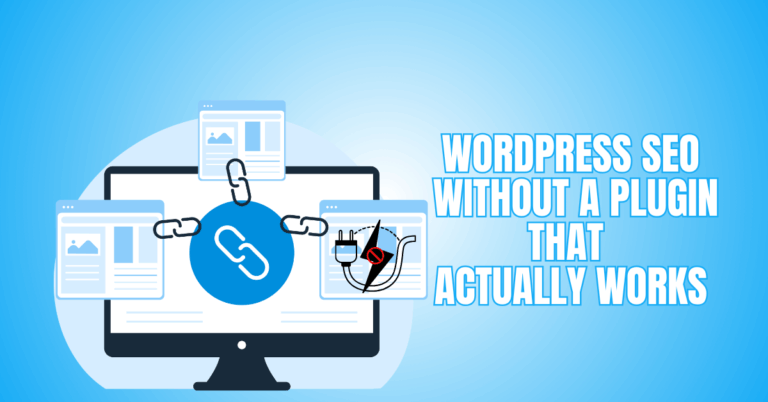Master SEO Competitive Analysis
Master SEO Competitive Analysis To Outrank The Competition
Want to outperform your online rivals and climb the search rankings faster? A smart strategy begins with understanding what others in your niche are doing right.
With the right tools and insights, you can uncover hidden opportunities, refine your content, and drive more targeted traffic.
This guide will walk you through everything you need to know about practical SEO competitive analysis for lasting success.

What Is An SEO Competitive Analysis?
An SEO competitive analysis evaluates your competitors’ search engine optimization strategies to understand what helps them rank highly in search results.
It involves identifying your top online competitors, analyzing their keywords, backlinks, content quality, technical SEO, and overall site structure.
You may increase the visibility of your website, find new keyword opportunities, and fill in strategy gaps by researching these components.
This analysis also reveals what content performs well in your niche, which websites link to your rivals, and how you can outperform them. Ultimately, SEO competitive analysis helps you make data-driven decisions to boost organic traffic and enhance rankings. It also lets you stay ahead in the search engine results pages (SERPs).
According to Neil Patel, a leading SEO expert, “Understanding your competitors’ SEO strategies lets you identify opportunities and avoid their mistakes, which is essential to outperform them in search rankings.”

Step-by-Step SEO Competitive Analysis Process
SEO competitive analysis helps you understand what works for your rivals and how to outperform them. Here's a step-by-step process to uncover their strategies and improve your rankings.
Step 1: Identify Your SEO Competitors
Begin by recognizing that SEO competitors are different from traditional business competitors. They’re the websites that rank for your target keywords, regardless of their business type.
Search your primary keywords on Google to identify them and note the top 10 ranking domains. Do this for multiple keywords to identify recurring competitors.
Use SEO tools like Ahrefs, SEMrush, or Moz to automate this process and analyze the SERPS (Search Engine Results Pages).
Want to Start Making Money Online?
Try My #1 Recommendation Program!
These platforms can show which domains dominate your niche and reveal whether your real competition is local, national, or international.
Local businesses may face competitors that are different from online-only brands. List the top 5–10 domains consistently appearing across your keyword set. These are your actual SEO competitors and will form the foundation for the following steps in your analysis.
Step 2: Analyze Their Keyword Strategy
Understanding your competitors' keyword strategy reveals their SEO roadmap. Start by entering a competitor’s domain into tools like Ahrefs (Site Explorer > Organic Keywords) or SEMrush (Domain Overview > Organic Search).
These tools show which keywords the site ranks for, their position, traffic volume, and keyword difficulty. Also, check Ubersuggest to gather additional insights. Identify their top-performing keywords to see what drives traffic.
Look for long-tail keywords they target—these often have lower competition and higher conversion potential. Use keyword gap tools (like Ahrefs or SEMrush’s Keyword Gap feature) to find terms they rank for that you don’t.
These gaps represent your content opportunities. Also, assess keyword trends over time to understand if they target evergreen content or seasonal topics.
Create a spreadsheet listing the valuable keywords, and categorize them by search intent (informational, transactional, navigational). This insight will guide your own keyword targeting and content development.
Step 3: Evaluate Their Content Strategy
Your competitors' content strategy reveals what resonates with their audience and Google's algorithm. Begin by visiting top-ranking pages manually.
Review content length—long-form posts often rank better, but balance quality with quantity. Check for multimedia use like images, infographics, or videos, which can improve engagement and SEO. Assess readability using tools like Hemingway or Grammarly; content should be scannable and user-friendly.
Inspect how they structure content—do they use subheadings (H2s, H3s), bullet points, and summaries? Look at internal linking—are they strategically linking to related content?
Want to Find Out How To Start Your Home-Based Business?
Try My #1 Recommendation Platform!
Finally, BuzzSumo can be used to find which of their articles get the most shares and backlinks, indicating content success.
Study their blog categories, publishing frequency, and topic diversity. Are they targeting beginner or expert readers? This level of content analysis helps you replicate their strengths and fill gaps they’ve missed, such as covering niche topics, updating older content, or adding more engaging visuals.
Step 4: Audit Their Backlink Profile
Backlinks remain a critical ranking factor. Start by analyzing your competitor's backlink profile using tools like Ahrefs (Backlink Checker), Moz (Link Explorer), or Majestic SEO.
Paste their domain into the tool to view all linking domains, total backlinks, domain authority scores, and the anchor text distribution.
Pay attention to the number and quality of referring domains—sites with higher authority linking back are more valuable.
Look at the top pages getting backlinks; these are their link-worthy assets. Also, analyze newly acquired vs. lost backlinks to understand their recent link-building performance.
Tools will also show if they rely on guest posts, directory links, or earned media. Identify backlink opportunities by contacting the exact referring domains or replicating high-performing content formats.
Consider conducting a link gap analysis to discover websites linking to your competitors but not to you. This information provides a roadmap for your own outreach and backlink strategy.
Step 5: Analyze Technical SEO
Technical SEO impacts crawlability, indexing, and user experience. Use tools like Google PageSpeed Insights, Screaming Frog, and SEMrush Site Audit to inspect your competitors’ technical health.
Begin by entering their URLS into these tools and reviewing key metrics like page load speed, mobile-friendliness, and core web vitals.
Screaming Frog helps detect broken links, duplicate content, and improper redirect chains. Examine their use of HTTPS for secure browsing and check indexability by viewing their robots.txt file and sitemap.xml (both accessible via [example.com/robots.txt] and [example.com/sitemap.xml]).
Tools will also indicate if their pages are optimized for structured data (schema markup), which enhances search result appearance. If they have minimal crawl errors and fast-loading pages, they're likely outperforming on technical SEO.
Benchmark your site against theirs and prioritize fixing load delays, mobile issues, and unindexed content. A strong technical foundation supports higher rankings and improves user satisfaction.
Step 6: Assess User Experience And On-Site SEO
A major factor in SEO effectiveness is user experience (UX). Visit your competitors’ websites and evaluate on-page SEO elements like title tags, meta descriptions, headings, and URL structure. Use browser extensions like SEOquake to scan these attributes.
Observe navigation clarity—is the menu intuitive and easy to use? Are CTAS (calls-to-action) strategically placed to guide users?
Are You Tired Of Scams?
Want to Start Making Money Online?
Check for responsive design by testing the desktop, tablet, and mobile sites. Tools like SimilarWeb provide bounce rate, time on site, and traffic sources, giving clues about UX. Analyze content layout—do they use white space, visuals, and logical flow to retain attention?
Good UX reduces bounce rate and boosts conversions. Identify what they do well and what you can improve, such as faster navigation, better CTAS, or enhanced content layout. A seamless on-site experience improves rankings and encourages visitors to engage and convert.
Step 7: Track Social Signals And Brand Presence
Social signals and brand authority affect user behaviour and organic traffic, although they are not directly ranking factors.
Use tools like Brand24 or Mention to monitor how often competitors are mentioned across blogs, news outlets, forums, and social platforms. Check BuzzSumo to identify which content types (e.g., listicles, videos, guides) get the most social engagement.
Use Social Blade to analyze followers' growth, post frequency, and engagement metrics on platforms like Instagram, YouTube, and TikTok. Note how often they collaborate with influencers, what hashtags they use, and how their audience interacts.
A strong brand presence often leads to increased branded search traffic, trust, and higher click-through rates in SERPs. If your competitor dominates social media, analyze their most shared content formats and mimic their strategy.
Integrating social proof with your SEO strategy strengthens your online visibility and enhances trust with your audience.

Best SEO Competitor Analysis Tool
Looking to outsmart your SEO rivals? These top competitor analysis tools help you uncover strategies, keywords, and backlinks your competitors use, giving you the insights needed to boost your rankings.
1. SEMrush
SEMrush is one of the most powerful and widely used SEO tools for digital marketers seeking deep insights into competitor strategies.
It allows users to analyze competing websites through features like Domain Overview, Traffic Analytics, Keyword Gap, and Backlink Gap.
You can see a comprehensive overview of your competitors' organic and sponsored search results using Domain Overview. This includes their top keywords and estimated traffic.
The Keyword and Backlink Gap tools identify missed opportunities by comparing your domain to competitors. Position Tracking helps monitor rankings over time.
Want To Learn How To Create Your Own Website And Online Business?
Try My #1 Recommendation Training And Hosting Platform!
SEMrush is known for its intuitive dashboard and robust reporting features, making it ideal for agencies and large-scale campaigns.
Pricing plans include Pro ($139.95/month), Guru ($249.95/month), and Business ($499.95/month). SEMrush boasts over 1.22 million active users globally, including SEO professionals, marketing agencies, and enterprises.
Its broad data coverage and precision make it a go-to solution for those serious about outperforming competitors in search engine rankings.
2. Ahrefs
Ahrefs is a highly respected SEO toolset known for its superior backlink and keyword data, making it invaluable for competitor analysis.
Its core feature, Site Explorer, lets users examine competitors’ backlink profiles, top-performing content, and organic traffic.
The Content Gap tool highlights areas for improvement by identifying keywords that other websites rank for but yours do not.
Ahrefs' Link Intersect feature reveals domains linking to multiple competitors but not you, which is perfect for building a stronger link profile.
The Top Pages report shows which content brings in the most traffic for competitors. Additional tools include Keyword Explorer, Rank Tracker, and a powerful Site Audit tool.
Ahrefs plans start at $99/month (Lite) and go up to $999/month (Enterprise). It serves over 49,000 companies globally. Ahrefs is a popular option for SEO specialists because of its extensive index and real-time data updates. It aids in improving link-building and content strategies and efficiently outranking competitors.
3. SpyFu
SpyFu is a keyword and competitor research tool designed to uncover competitors’ SEO and PPC strategies. Its standout feature, Kombat, allows you to compare your site with multiple competitors to discover shared and unique keywords.
This helps identify content gaps and keyword opportunities. SpyFu also provides detailed SEO and PPC research, showing competitors’ top-ranking keywords, backlinks, historical data, and even their Google Ads spend and ad copy.
The platform’s backlink tools help uncover linking domains used by competitors, allowing for more targeted outreach strategies. SpyFu’s interface is beginner-friendly, making it accessible for small businesses and marketers.
Pricing is affordable, starting at $39/month for the Basic plan and going up to $299/month for the Team plan, with unlimited data access across all plans.
While the exact number of users is undisclosed, it’s widely adopted by digital marketers, agencies, and entrepreneurs who want actionable insights into their competitors' keyword and advertising performance.
4. Ubersuggest
Ubersuggest, created by marketing expert Neil Patel, is a budget-friendly SEO tool perfect for beginners and small businesses looking to conduct competitor analysis.
Users can enter a competitor’s domain to receive insights on top-ranking keywords, traffic data, and backlink profiles. Ubersuggest's Traffic Analyzer reveals your competitor’s most visited pages, estimated visits, and primary keywords.
The SEO Keywords and Content Ideas sections highlight keyword opportunities and high-performing content that resonates with audiences.
Its simple dashboard also includes a site audit tool that flags technical SEO issues. Ubersuggest is especially helpful for content strategy, showing what topics drive traffic for your competition.
It’s among the most affordable tools, with monthly plans starting at just $12 for Individuals, $20 for Business, and $40 for Enterprise/Agency users.
Although it doesn’t disclose official user numbers, its popularity has surged among freelancers, bloggers, and startups who want to boost their SEO without investing in more expensive platforms.
5. Serpstat
Serpstat is an all-in-one SEO platform that supports competitive analysis, keyword research, site auditing, and rank tracking.
It excels in analyzing competitors by providing detailed keyword and domain insights. With the Competitor Analysis tool, users can uncover which keywords competitors rank for, their traffic sources, and backlink profiles.
The Tree View feature offers a visual breakdown of a competitor's site structure and keyword distribution, which helps plan your own SEO architecture.
Serpstat also allows rank tracking to monitor how you and your competitors perform over time in search engines. It's extreme in regional search data, making it useful for businesses targeting specific geographic markets.
Pricing plans start at $69/month (Lite) and go up to $499/month (Enterprise), catering to freelancers and large teams. While exact user numbers are not published, Serpstat is used by SEO specialists, agencies, and enterprises looking for a more affordable alternative to big-name tools like SEMrush and Ahrefs.
6. BuzzSumo
A content-focused platform called BuzzSumo assists marketers in determining the kinds of material that appeal to their target demographic.
It also shows how competitors perform across social media. Its Content Analyzer feature lets you see the most shared competitor content by platform, helping guide your content strategy.
BuzzSumo’s Backlink Analysis tool also reveals who’s linking to your competitors, aiding in building a robust outreach plan.
One standout feature is influencer identification, allowing you to find people amplifying your competitors’ content so you can target them in your campaigns.
Additionally, BuzzSumo includes content alerts and brand monitoring tools that help track mentions and trending content.
Pricing starts at $199/month (Content Creation), scaling to $999/month (Enterprise). Although its user base is not publicly disclosed, BuzzSumo is widely trusted by PR professionals, content marketers, and digital strategists who want to build viral content campaigns informed by real competitor performance data.
7. Moz Pro
Moz Pro is a widely respected SEO platform known for its clean interface and comprehensive toolkit that caters to marketers at all skill levels.
Its competitor analysis features include Keyword Explorer, which uncovers keyword opportunities by comparing your site to rivals, and Link Explorer, which provides detailed insights into competitors’ backlink profiles, including domain authority and spam score metrics.
Moz Pro also offers on-page optimization to help refine your content strategy and a rank tracker to monitor your search rankings and those of your competitors over time.
The platform’s famous Domain Authority metric is a benchmark for website authority and is trusted industry-wide. The Standard plan of Moz Pro costs $99 per month, while the Premium plan costs $599 per month.
It accommodates businesses from small startups to large agencies. With over 500,000 users globally, Moz Pro is favoured by SEO professionals, content marketers, and agencies looking for actionable data and user-friendly tools to improve their search visibility.
FAQs
How Often Should I Perform SEO Competitive Analysis?
At least quarterly, or whenever launching a new campaign or noticing ranking changes.
Can I Analyze More Than One Competitor?
Yes, and you should. Analyzing 3–5 competitors gives a well-rounded view.
Is SEO Competitive Analysis Useful For Local Businesses?
Absolutely. Local SEO competitors often differ from national ones, and insights are key to local ranking.
Conclusion
Staying ahead in the digital space means constantly learning from your competitors. Using the insights gained through SEO competitive analysis, you can make smarter decisions, improve your content, and strengthen your overall strategy.
Remember, success doesn’t come from guessing—it comes from informed action. Keep refining, stay consistent, and watch your rankings grow. Ready to take your SEO game to the next level? Start analyzing and lead with confidence.
I trust you enjoyed this article about Master SEO Competitive Analysis To Outrank The Competition. Please stay tuned for more articles. Take care!
JeannetteZ
Want to Learn How to Build Your Own Home-Based Online Business And Start Making Money Online From Your Comfortable Couch?
Try Wealthy Affiliate!
Your Opinion Is Important To Me
Do you have thoughts, ideas, or questions? I would love to hear from you. Please share your questions, experiences, remarks, and suggestions about Master SEO Competitive Analysis to Outrank the Competition in the comments below. You can also email me at Jeannette@WorkFromAnywhereInTheWorld.com.
Disclosure
This post may contain affiliate links. I earn from qualifying purchases as an Amazon Associate and through other affiliate programs. Please read my full affiliate disclosure.
You may also enjoy the following articles:
Wealthy Affiliate Coupons For Premium Memberships
Wealthy Affiliate Review – Scam or Legit? The Truth Exposed
An Insider Wealthy Affiliate Review
13 Ways To Make Your Content Better
The 9 Best Phone Apps For Blogging







